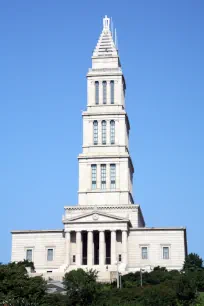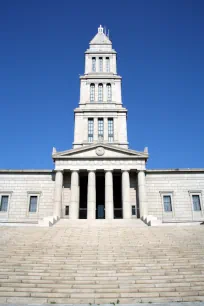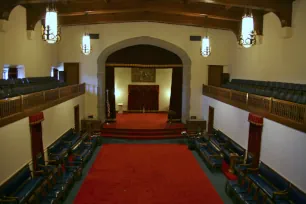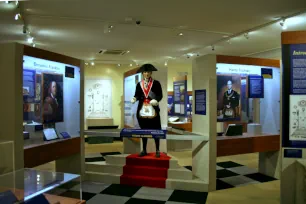The George Washington Masonic National Memorial was built in the early twentieth century in honor of George Washington, a Freemason. The memorial is also an active Masonic temple.



The memorial is perched atop a hill in Alexandria, just south of Washington, and towers over the neighborhood. Despite its relatively remote location, it is easily reached since there is a metro station right nearby (King Street); you can even see the building from the platforms.
Freemasons
Many of the Revolutionary leaders were Freemasons, members of a fraternity that has its roots in the stonemason guilds of the fourteenth century. Where in the Middle Ages people sought spiritual guidance in religion, Freemasonry offered more practical guidance for members in their profession and life in general. One can only become a member by recommendation. New members are called apprentices. Through ceremonials, rituals and other activities they can attain the rank of fellow and later master mason.
The Memorial
Construction
George Washington, the first President of the United States, was also the first master of the Alexandria lodge. In 1910 Freemasons decided to erect a large memorial in his honor. The construction was funded with donations given by lodges and individuals from around the country. The first cornerstone of the building was laid on November 1, 1923, with the silver trowel that George Washington had used to lay the first cornerstone of the US Capitol. The memorial was dedicated nine years later, on May 12, 1932.
Architecture
The 333 ft / 101.5 m tall memorial consists of a temple-like base from which rises a slender tower with setbacks, topped with a pyramidal-shaped stepped spire and culminating in a finial. The base has a massive neoclassical Doric portico, a reference to the democratic values of Ancient Greece. The design for the tower was inspired by one of the seven great wonders of the Ancient World: the Pharos of Alexandria, a soaring lighthouse in the harbor of Alexandria, Egypt that was built by a Hellenistic kingdom in the third century BC. The three levels of the tower are each decorated with pilasters in a different order: The bottom ones are Doric, the middle pilasters are Ionic and the top is Corinthian in style. The finial resembles a flame, a reference to the ancient lighthouse, and symbolizes the memorial as a beacon of Freemasonry.
Interior



Enter the memorial through the portico into the Memorial hall, and you’ll stand face to face with a monumental statue of George Washington. The statue was installed here in 1950 and stands in an exedra with a coffered ceiling.
Murals behind massive granite columns depict scenes in the life of George Washington. The mural on the south wall depicts Washington attending mass in Philadelphia’s Christ Church. On the north wall, Washington is shown laying the cornerstone of the US Capitol.
Descend the stairs to visit the lodge rooms, where the Masonic rituals are enacted. The first room is a replica of the lodge room from 1802, complete with original furniture. The North Room is designed in Gothic style and features oak balconies and arches. The South Room in contrast is neoclassical in style. Other notable rooms include the Grand Masonic Hall, with eight massive columns, and the theater, with a seating capacity of four hundred.
Throughout the building you can see memorabilia, paintings and photos of famous Freemasons, and drawings of other Masonic temples. If you want to learn more about the history of freemasonry in the United States, make sure you visit the Founding Hall Exhibit, which gives background info on freemasonry in general and puts the spotlight on some of the most famous Freemasons in US history, including Benjamin Franklin and several former US presidents.
If you take a guided tour, you can also visit the observation platform at the top of the tower, from where you have a magnificent view that stretches all the way to the Washington Monument and beyond.

